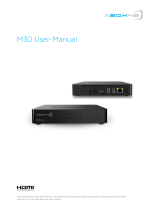
PG 3
MYTANA M20T / M20 / M30 Jetter USER MANUAL
Pumps Remove “shipping” plug on top side of
pumps and replace with vented plug. This is very
important for the proper operation of the pumps.
Do not store or run the pumps on its side or at a
sharp angle, since oil can run out of the vent plug.
Keep bystanders or unauthorized persons away
Insist they keep a safe distance before operating
high pressure equipment!
Environment
• Use caution in conned or wet areas. Since you will
often be working directly through clean outs or
openings into sewers (non-trapped openings) make
sure that there is adequate ventilation into the work
area.
• Do not operate machine in areas where
ammable gases or liquids are present.
Always insert hose and nozzle into pipe opening and hold
onto hose before turning the machine on.
Changing hose and/or nozzle ALWAYS turn machine o
when changing nozzles, hoses or reels.
Never hold onto nozzle or point it at anyone with
machine turned on. High pressure water streams can
cause serious bodily harm.
Job Completion Always turn machine o before
disconnecting water supply. Running a water pump “dry”
will seriously damage the water pump.
Maintenance
• Keep machine clean and dry to maximize performance
and longevity.
• Follow maintenance schedules such as changing oil,
check for weak spots, slices or cuts in hose, keep inlet
screen clean, replace nozzles when worn.
• Keep antifreeze in hose and pump in freezing
temperatures.
• Additional maintenance details follow in this manual.
Common Sense Don’t operate equipment under the
inuence of drugs, alcohol or if taking medication that
alters alertness.
Electric machines
• Avoid electric shock! Before using your electric
machine, make sure that a properly grounded
outlet (three hole) is available. If one is not
available, use a three prong adapter making sure
to connect the green pigtail from the adapter to a
sure ground, such as a steel water pipe.
Never run your jetting machine without a
properly grounded electrical supply and
hookup! This is electric equipment in a wet
environment. Every precaution should be taken
when water and electricity are in close proximity.
• Use 12 gauge or heavier extension cords to power
the machine.
• Never spray motor or electrical connections directly
with a water stream.
• Avoid getting the electrical connections and
components wet.
Gas Jetters
• Always operate machine in well ventilated environ-
ment. Exhaust fumes can be potentially lethal to the
operator.
• Do not allow ame or sparks in the area of operation.
• Do not refuel engine when it is hot. Spilled gasoline
or gas vapor can ignite if it comes in contact with hot
engine.
• Be careful not to touch engine block or the manifold/
muer during operation. These areas will become
very hot during normal operation.
• Do not lay machine on its side or tilt it backwards
(other than wheeling it from place to place). This can
cause gas to leak out the cap vent.
uBecause the gas jetter is tilted back about 30°
for transport, do not ll the gas tank all the way.
Leave several inches of space between the gas
and the top of the tank to prevent gas from
leaking out.
Gas jetters that are ordered with an electric starter
package will have a battery attached. Batteries contain
sulfuric acid. Avoid direct skin contact. Wear protec-
tive gloves, clothing and eyewear when handling your
battery!
Safety First! Instructions and Precautions
Vented
Plug










